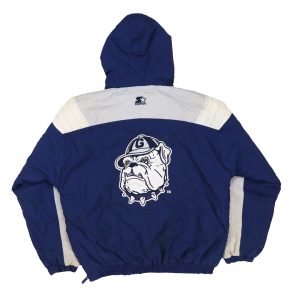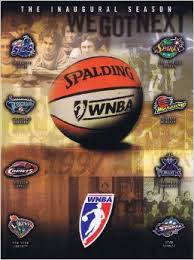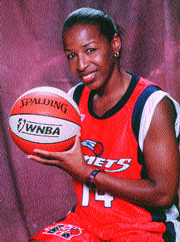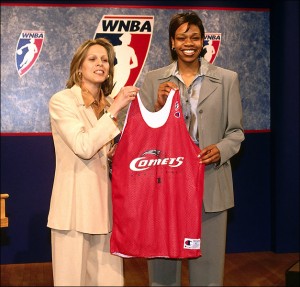
Barring the integration of the NCAA in the late 1940’s, the 1990’s marked one of the most transformative periods for college basketball. Never before had teams and individual players set so many trends, both on and off the court. The emergence and high utilization of the newly formed three point line, fast breaking teams regularly scoring well over 100 points, and high profile recruiting camps for high school prospects caused the game to be played in a more fluid way. Players were becoming more individually skilled and discovered at increasingly younger ages. From a fashion and cultural perspective, the prevalence of baggy t-shirts under jerseys, the Michigan “Fab 5” wearing black shoes and black socks, and the emergence of long shorts showed that college players were starting trends that carried over into the mainstream. During 90’s, there was one team that stood out the most. Georgetown University Men’s Basketball did not win any championships in the 90’s.[1] How could a team without any hardware make such an impact? Sporting a hard nosed, in-your-face-style of play, trendsetting, edgy players, and a giant of a coach, Georgetown came to define the transformative era that was 90’s college basketball.[2]
In the context of the African American experience in the 1990’s, it’s worth noting that Georgetown is not an HCBU. Given the majority white demographics of the school, the team was mostly African American in the 1990’s, and John Thompson Jr. is an African American coach. Upon arrival at Georgetown in the late 1970’s, Thompson endured racial slurs thrown at him by disgruntled alumni and was thought to be an ineffective coach due to the color of his skin.[3] Thompson worked hard to prove everyone wrong. The 1980’s brought a national championship and a 96% graduation rating of his players. Viewed by his players as more of a father figure than a basketball coach, his style was domineering and controlling. He limited player interactions with the media and kept close tabs on his team on road trips. This style wasn’t limited to his players. Coach Thompson was known to suspend himself for games if the team’s grade point average was not above the NCAA average.[4] This emphasis on player development and off-the-court accountability was counter to the emerging NCAA recruiting scandals of the late 1980’s and 1990’s. With recent announcement of an FBI an investigation into some of the top “blueblood” basketball programs for paying off players and other forms of corruption, this continues to plague the NCAA to this day.[5]
Georgetown’s snarling Hoya bulldog logo was trademarked by the University in the mid-1980’s, and Georgetown basketball started to emerge as one of the first brands in college sports. [6] By the early 1990’s Georgetown basketball apparel was regularly outselling power football conference brands.[7] Georgetown Starter jackets and jerseys became wildly popular across the United States. The team was especially resonant with black America. The team was all-black, had a black coach, and played in a majority black-ran city (with a black mayor).[8] Washington D.C. had been called “The Chocolate City” for some time, and what was previously a predominantly white team full of former parochial league players gave way to a majority-black team with some players who came from single-parent households, disadvantaged neighborhoods, and junior colleges.[9] Georgetown went from having a small and regional following to having the aura of a national professional sports team.[10]
The arrival of a recruit from Bethel High School in Hampton, Virginia marked Georgetown’s most successful period the 1990’s. Allen Iverson was fresh off of an overturned conviction stemming from a bowling alley brawl and made an immediate impact on the court. Iverson averaged over 20 points a game his freshman season and was named Big East Conference Rookie of the Year. The Georgetown uniforms during Iverson’s career at the school featured Kente cloth pattern on the side of the jersey and shorts. This symbol of African pride was a nod to the team’s roots. The Kente cloth originated in the Ashanti Kingdom and was adopted by other West African countries; the pattern was considered to be the cloth of kings.[11] To complement their jerseys, the team wore Air Jordan XII Concords; to this day they are among the most coveted Air Jordan sneaker. Fans loved their uniforms but most appreciated Iverson’s scrappy and tenacious play. An undersized player, he played both the point and shooting guard positions. His size did not matter—he possessed a 41 inch vertical leap and led the Big East in steals. His signature crossover dribble became legendary and young players across the country began to emulate the move.[12] Along with Iverson, people appreciated the tough play of Jerome “Junkyard Dog” Williams, Othella Harrington, and Jihadi White—hard-nosed forwards who did not back down from anyone. After two seasons at Georgetown, Iverson became the first Georgetown player under John Thompson Jr. to leave early for the NBA Draft.[13]
Iverson’s departure from Georgetown marked the start of the decline of Georgetown basketball in the 1990’s. Despite winning a regular season conference title the year after he left, the Hoyas lost in the first round of the NCAA tournament. As progressive as Coach Thompson had been to let his team celebrate their black roots and embrace their culture, Georgetown did not progress in terms of basketball. Teams were becoming more adept at three point shooting and were able to handle full court pressure. Being bigger and quicker than most teams was not as effective as it was in the past.[14] Coach Thompson subsequently retired in 1999, citing difficulties in his marriage. The school’s licensing revenues fell out of the top 50 in recent years.[15] The late 2000’s offered a glimmer of hope for a return to national prominence. Using a non-traditional, slowed down Princeton-style offense, Thompson’s son, John Thompson III, led the team to a Final Four in 2007. Thompson III found trouble duplicating that success and was ultimately removed from the head coaching job in 2017. The recent hire of Patrick Ewing, an NBA Hall of Famer and member of the 1984 National Championship team, has excited the fan base and hopes are high to get the team back to Thompson Jr.’s glory days. Basketball aside, it will be hard to top the impact that the 90’s Georgetown team made on a campus, city, and national level.—Jeff Brown
[1] They came close: an NIT runner-up in 1993, and a trip the Sweet Sixteen in 1994, and an Elite Eight in 1996. Thompson won his only championship at Georgetown in 1984. Georgetown also made a postseason tournament every year Thompson coached in the 1990’s.
[2] “Black History Month: Remember When the Georgetown Hoyas Wore Kente Cloth?” The Sports Fan Journal, February 16, 2016, http://www.thesportsfanjournal.com/sports/basketball/black-history-month-remember-georgetown-hoyas-wore-kente-cloth/. Coach John Thompson Jr. is listed at six feet, ten inches tall. Before he became a coach, he was an All American center at Providence College in the 1960’s. He also had a renowned temper and was known to lash out at his players and the media.
[3] Bruce Lowitt and Ira Rosenfeld, “John Thompson: A firm hand at the helm,” The Free Lance-Star, March 16, 1985, 11-12. https://news.google.com/newspapers?id=uOJLAAAAIBAJ&sjid=9osDAAAAIBAJ&pg=800,2451944&hl=en.
[4] Rosenfeld, “Thompson,” 11.
[5] Marc Tracy, “N.C.A.A. Coaches, Adidas Executive Face Charges; Pitino’s Program Implicated,” The New York Times, September 26, 2017. https://www.nytimes.com/2017/09/26/sports/ncaa-adidas-bribery.html.
[6]Mike Debonis, “The World’s Most Dangerous Basketball Team,” Slate, March 29, 2007. http://www.slate.com/articles/sports/sports_nut/2007/03/the_worlds_most_dangerous_basketball_team.html.
[7] Debonis, “Dangerous.”
[8] Debonis, “Dangerous.” Marion Barry was the mayor from 1979-1991 and 1995-1999. Other successful African Americans like Kweisi Mfume and Elijah Cummings held admirable positions in the DMV area.
[9] Sports Fan Journal, “Black.”
[10] The inconsistency of the 1990’s Baltimore Bullets/Washington Wizards made the popularity of Georgetown basketball even greater.
[11] Sports Fan Journal, “Black.”
[12] Iverson used the crossover move on Michael Jordan in his rookie season to cement himself as one of the league’s most exciting and up-and-coming players.
[13] Paolo B. Santamaria, “Allen Iverson Reflects Georgetown Values,” The Hoya, September 16, 2016. http://www.thehoya.com/mens-basketball-allen-iverson-reflects-georgetown-values/.
[14] Iverson was certainly undersized at 6’0”, but Thompson was renowned for recruiting strong, 6’10” plus forwards (e.g. Patrick Ewing, Alonzo Morning, Dikembe Mutumbo).
[15] Debonis, “Dangerous.”




